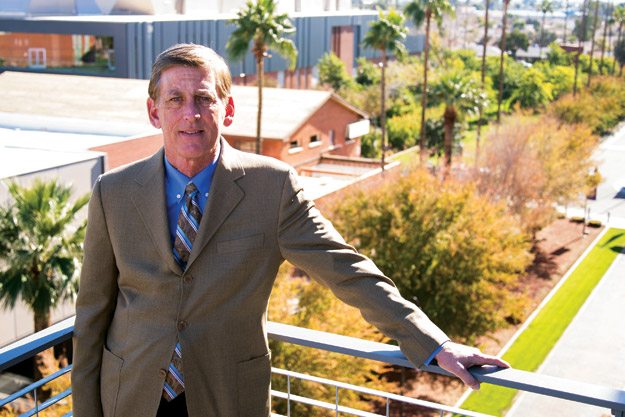Brian Mueller has created the most successful business model in education. When he took over as Grand Canyon University’s CEO in 2008, there were less than 1,000 students on campus and about 10,000 online. Today, GCU has 8,500 students on campus and 50,000 online, with a new East Valley campus coming in 2015. Mueller has also expanded GCU’s science, technology, engineering and math offering with the launch of its College of Science of Engineering and Technology.
Az Business magazine caught up with the Antelopes’ biggest fan to find out how he helped GCU make the grade in business and with the books.
Az Business: How has the business model for higher education changed?
Brian Mueller: If you think of the 1970s, 1980s and 1990s, universities built their reputations based on the quality of their traditional-age students. Then, a market opened up with adults who wanted to go back to college and earn degrees while they were working and raising families. Most of the universities that ended up serving those students were private, for-profit universities and there was far greater demand than supply. You could grow as fast as you wanted and charge whatever you wanted and people were willing to pay for that convenience.
Everything changed in 2008. Tax dollars that helped fund public universities were in decline and donor bases dried up. Those mid-tier universities were forced to look to the adult market, which flipped the supply-demand in favor of the working adult student.
AB: How did you use that change in the marketplace to help GCU?
BM: I came here in 2008 because I saw an opportunity to create a hybrid campus — a strong traditional campus with a strong component of working adults — that shared a common infrastructure and spread the costs across two students bodies. By creating a hybrid campus, we were able to lower the price point significantly. After scholarships, the average GCU student pays $7,800 in tuition. Most students at private universities pay between $25,000 and $50,000 a year.
AB: How did you make that happen so quickly?
BM: I believed if we could get an infusion of funds, we could create something special. We came in June 2008, went public in November, got an infusion of $254 million, put huge dollars back into the ground campus and went to work building a brand based on the excellence of the education.
AB: How did you get investors to buy into the IPO in 2008?
BM: We were the first company to go public in three months, but I had been at Apollo Group for 22 years and was the CEO of the University of Phoenix Online when we went public as a tracking stock between 2000 and 2004, which turned out to be the most successful tracking stock in the history of Wall Street. So I knew those guys and they had made good dollars with us before. They didn’t completely buy the business model. Nobody believed that you could be successful or profitable with traditional students because it would always be a money loser. But the truth is our level of profitability is now about the same on both sides.
AB: What has been your biggest professional challenge?
BM: There were not many people doing online education in 1997, but we saw it was going to be huge. We had to fight the traditional academic community, who said, “How dare you deliver education online? Students need to be in a classroom with a professor.” The push-back was so strong that we just needed to push through it, accept the criticism, make counter-arguments and keep moving forward. Those same people who were yelling at me in 1997 are all trying to do the same thing now.
AB: What are your goals for GCU?
BM: Ten years from now, we will have 25,000 students on our physical campuses. Online, we will have 80,000 or 90,000 students. We want to be a university that provides excellent education, but in a values-based context and environment. And we want to operate as a company that helps transform the West Valley.




